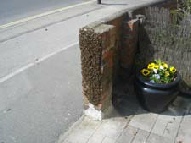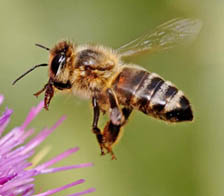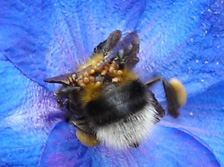


Holsworthy Beekeepers is a branch of Devon Beekeepers Association
Registered Charity Number 270675
Site last updated on:
04/11/2025
Swarms and swarm collection
 Beekeepers spend a lot of time trying to prevent their bees swarming but inevitably some get away (apparently the bees have read a different book to the rest of us!) However most beekeepers are very keen to retrieve a swarm of bees and are happy to be contacted by members of the public requesting help.
Beekeepers spend a lot of time trying to prevent their bees swarming but inevitably some get away (apparently the bees have read a different book to the rest of us!) However most beekeepers are very keen to retrieve a swarm of bees and are happy to be contacted by members of the public requesting help.
Please visit The British Beekeepers website for details of swarm control officers in your area.
Many insects produce swarms as part of their natural instinct to set up another family, or colony. A hive of bees, when the conditions are right will decide to split into two, three or even more separate new colonies and over the course of a day each new colony, or swarm, will emerge from the hive and fly off to find a new home.
to set up another family, or colony. A hive of bees, when the conditions are right will decide to split into two, three or even more separate new colonies and over the course of a day each new colony, or swarm, will emerge from the hive and fly off to find a new home.
Before leaving the hive, every bee will gorge herself on honey so that she has enough food for the journey. This is a good thing for anyone who encounters a swarm because having a stomach makes the bee very placid makes it difficult to bend and sting a human.
Usually swarms leave the hive during the middle of a warm sunny day in the spring or early summer and initially do not fly far but will cluster on a suitable low hanging branch. This gives them an opportunity to regroup before flying off to their new home. It is when the swarm is in this condition that is easiest to retrieve because not only are they full of food but they do not have brood (young) to protect or a home to defend, in fact they are concentrating on finding a new home. This is when a local beekeeper will be able to easily collect them. However what usually happens is that the beekeeper arrives just after the swarm has left or the swarm is 30 feet up the tree.
|
Honey bee, wasp or bumble bee?
When contacted about a 'swarm' the first thing a beekeeper will ask is 'Are they honey bees?'
These pictures may help in making the correct identification
|
|
A honey bee, (apis mellifera)
Honeybees vary in colour, from almost black to a golden brown.
|

|
|
A bumble bee
Harmless and endangered so please leave them to get on with their business
|
.
|
|
Asian hornets
For information on Asian hornets, including how to identify/report them and to obtain an app for your smart phone, please click here.
|



 Beekeepers spend a lot of time trying to prevent their bees swarming but inevitably some get away (apparently the bees have read a different book to the rest of us!) However most beekeepers are very keen to retrieve a swarm of bees and are happy to be contacted by members of the public requesting help.
Beekeepers spend a lot of time trying to prevent their bees swarming but inevitably some get away (apparently the bees have read a different book to the rest of us!) However most beekeepers are very keen to retrieve a swarm of bees and are happy to be contacted by members of the public requesting help. to set up another family, or colony. A hive of bees, when the conditions are right will decide to split into two, three or even more separate new colonies and over the course of a day each new colony, or swarm, will emerge from the hive and fly off to find a new home.
to set up another family, or colony. A hive of bees, when the conditions are right will decide to split into two, three or even more separate new colonies and over the course of a day each new colony, or swarm, will emerge from the hive and fly off to find a new home.
